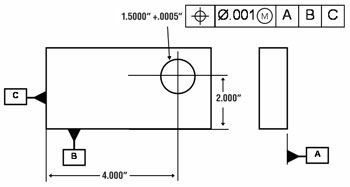Manual Calculation Of True Position Tolerancing
- Posted in:Admin
- 07/05/18
- 23


Negative Tolerance numbers indicate out of tolerance condition. This GD&T true position calculator will convert coordinate measurements to position tolerances. Two (2) inputs are required, See the application illustration at bottom of page. Geometrical Dimensioning & Tolerancing (GD&T) MEM 201. Department of Mechanical Engineering and Mechanics. The calculation formula for allowance is.
The formula for calculating true position is true position tolerance = 2 x SQRT(XVAR2 + YVAR2). In this instance, SQRT refers to a square root, XVAR refers to the. Compensation Calculations. TRUE POSITION CALCULATOR FOR HOLES HOW TO USE TABLE. Calculation showing how much deviation is allowed in Basic Dimensions ( X Location and Y location). GD&T stands for geometric dimensioning and tolerancing. Tolerance Stack - A calculation used to find. Manual Calculation Of True Position.
NOTE: The calculator is incomplete and additional features will be added later on. Please report any bugs or erroneous results. The true position calculator is a tool to calculate the true position of the center axis after actual measured dimensional data is entered about a manufactured feature: either a hole or a shaft. It is compared to a theoretically exact target feature as described on a technical drawing document. Download Lagu Noah Aku Hidup Untukmu Aku Mati Tanpamu Mp3 Take. Please note that not all possible combination of control frame features are supported by this calculator. The position control frame found on technical drawing documents are used to allocate an acceptable deviation to a hole or a shaft feature. One basic function of the true position tolerance is to prevent a component from forcing another component out of alignment at assembly time.
It takes into consideration the allowable deviation of sizes of the relevant features of an assembly. For example: a screw that binds multiple components together.
The position control frame can also be seen as a way to ensure exact positioning, within acceptable deviation limits, of multiple components of an assembly. For example; dowel pins that slide into positioning holes. Recommended Usage Flow. • Select the type of feature; hole or shaft.
• Define the feature diameter basic size and deviation. • Fill control frame data, positional diameter, boundary condition, whether the target is projected and the projected distance. • Define the primary, secondary and tertiary datum plane label identifiers. • Enter the target distances of the feature to the secondary and tertiary datum planes. • Select the type of measurement type that is most appropriate.
• Enter the measured dimensional data. • Compute all the data entered and evaluate results. Target Feature Box.
This section is where the type, size, position and deviation allowances of the feature are defined. Feature Type: Select the type of feature that will be evaluated.
It can be a hole or a shaft. Size of the feature: 3 ways are offered to define the minimum and maximum size of the feature.
These values will affect the boundary condition of the positional tolerance. The bonus value if it applies. This is the where the actual measured size and position dimensions of the feature are entered. There are 3 ways to describe the actual size and position of the manufactured feature. 1- Basic position: - NOTE: All the dimensions are located on the primary datum plane.
A) The actual diameter of the feature b) The actual distance of the center of the feature to the secondary datum plane c) The actual distance of the center of the feature to the tertiary datum plane - NOTE: The projected distance is not considered. 2- Position and feature height - 2 sets of dimensions must be entered. The first set of measurements must be taken at the primary datum plane.